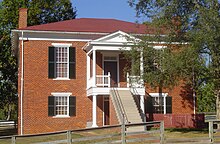Appomattox Court House
| Appomattox Court House National Historical Park | ||
|---|---|---|
| McLean House, where the deed of surrender was signed | ||
|
|
||
| Location: | Virginia , United States | |
| Next city: | Lynchburg | |
| Surface: | 4 km² | |
| Founding: | April 10, 1940 | |
| Visitors: | 303,139 (2016) | |
Appomattox Court House is a National Historical Park of the United States in the state of Virginia , who at the end of the Civil War recalls. In the small, now uninhabited town about 30 kilometers east of Lynchburg , the Northern Virginia Army of the Confederate States of America under General Robert E. Lee surrendered to the troops of the Union under Lieutenant General Ulysses S. Grant on April 9, 1865 . Although there were occasional further fighting afterwards, this surrender is considered the end of the civil war between northern and southern states .
The surrender
After the fall of Richmond , the capital of the Confederation, General Lee planned to move south with the remnants of the Northern Virginia Army and unite them with General Joseph E. Johnston's Tennessee Army . At Appomattox Court House, however, Lee's units were overtaken and surrounded by General Grant's James and Potomac armies . Early in the morning of April 9, a final attack by Confederate troops failed at the Battle of Appomattox . Thereupon Lee decided to see Grant and comply with his request to surrender. Grant's terms were extremely generous: all the Confederate soldiers had to do was surrender their weapons; they were then free to go home.
Since April 9th fell on a Sunday, the courthouse , after which Appomattox Court House is named, was closed. The signing of the deed of surrender did not take place there, but in the nearby private house of the farmer Wilmer McLean . A historical coincidence had had it that McLean also owned a farm in Manassas on whose land the First Battle of Bull Run , the first of the Civil War, had taken place four years earlier . So McLean later stated with some justification that the war had started in his front yard and ended in his living room.
Appomattox today
The small town of Appomattox Court House, which consisted of only a few farm houses, a shop and a courthouse, was abandoned at the end of the 19th century . It deteriorated noticeably in the following decades, especially since in the former Confederate state of Virginia there was no need to set up a memorial at the site of a defeat. It was not until April 10, 1940 that the US Congress declared Appomattox Court House a National Historical Park. The remaining buildings were partly restored, partly reproduced and the surrounding farmland of approx. 4 km², on which the two opposing armies had camped in 1865, declared a memorial. Today Appomattox Court House is a large open air museum owned by the US federal government and operated by the National Park Service .
literature
- Appomattox Court House National Historical Park, Virginia , Handbook 109 - National Park Service, Washington DC 1980 (100-page National Park Administration brochure)
- James M. McPherson : Die for Freedom. The history of the American Civil War , Munich a. Leipzig 1988, ISBN 3-471-78178-1 (one-volume standard work on the American Civil War).
- Shelby Foote : The Civil War. A Narrative, Vol. 3: Red River to Appomattox , New York 1974, ISBN 0-7126-9812-4 (third volume of the extensive standard work by Foote with a detailed description of the events of Appomattox).
Web links
- National Park Service: Appomattox Court House (official site; English)
Individual evidence
- ^ Stats Report Viewer. National Park Service , accessed on December 27, 2017 (select the appropriate entry under "Park").




